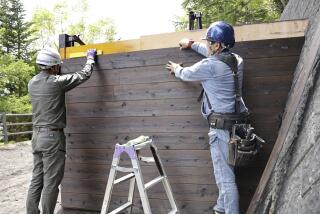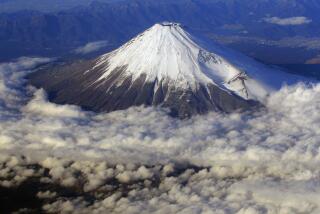Adventurers Have Heard the Call of the Wild Worldwide
TOKYO — Japanese explorers and adventurers have wandered the globe for centuries, expanding the horizons of their narrow island nation.
Japanese joined silk-trading caravans that traversed China’s western deserts centuries ago. Religious ascetics began climbing Japanese mountains in the 8th Century, believing them to be the dwelling places of gods.
In a nation that is 85% mountains, mountaineering is a natural pastime, although deserts and seas are equally tempting.
Junko Tabei, who in 1975 became the first woman to climb Mt. Everest, belongs to a long line of Japanese adventurers:
* Naomi Uemura is venerated as Japan’s pioneer alpinist and explorer. Stricken by wanderlust after he graduated from Meiji University in 1964, Uemura lived hand-to-mouth as he conquered the world’s highest peaks, including Everest. He was the first man to trek alone to the North Pole, in 1978. He then sledged from Alaska to Greenland. Uemura died in 1984, on his 43rd birthday, when he disappeared mysteriously while descending Alaska’s Mt. McKinley.
* Veteran sailor Kenichi Horie was the first yachtsman to cross the Pacific alone, from Japan to San Francisco, in 1962 at age 23. He circled the world alone in 276 days in 1974. He completed the world’s first north-south circumnavigation in 1982.
* Not satisfied with reaching the North Pole by motorcycle, adventurer Shinji Kazama plans to bike to the South Pole next November. Kazama also has biked across a glacier on the face of Mt. Everest.
Tabei says Japanese embark on such escapades to surmount the confines of their small island nation.
“Japan is such a small country,” she says. “It’s isolated from the rest of the world. It doesn’t have really tall mountains or deserts.
“Until recently, Japanese weren’t blessed with the chance to travel, but now they can. I think we just really want to see the rest of the world, to go beyond our own limitations.”
Curiosity and thirst for adventure, however, have been the undoing of many Japanese.
In late January, a team of 11 Japanese and six Chinese disappeared while trying to scale 22,242-foot Mt. Meili in southwestern China. The climbers are thought to have been buried by avalanches.
Balloonist Fumio Niwa, 40, drowned in January while trying to cross the Pacific alone in a helium balloon.
Three Japanese balloonists who tried to fly over Mt. Everest--another would-be first--were luckier. One man suffered leg injuries and two others escaped unhurt when their balloon crashed into a cliff in Tibet and burned.
An unofficial estimate by the Japan Himalaya Assn. in 1989 put the number of deaths by Japanese climbers in the Himalayas since 1952 at 176, or one in every 40.
In 1989, 178 Japanese died while mountain climbing in Japan and nine died overseas.
The highest of Japan’s many mountains, Mt. Fuji, is only 12,388 feet high. But many peaks are dauntingly rugged, and defiant climbers often brave blizzards and ice in winter assaults.
Tabei says that the Japanese, who generally tend to be very careful and well organized, fare no worse than adventurers of other nationalities.
“It’s the media’s fault,” she says. “Whenever someone gets lost, they play it up with maps and pictures. They make the mountains seem like something scary.”
More to Read
Sign up for Essential California
The most important California stories and recommendations in your inbox every morning.
You may occasionally receive promotional content from the Los Angeles Times.










